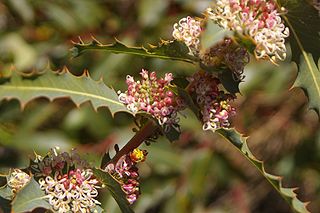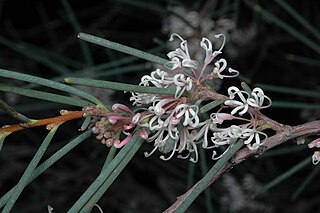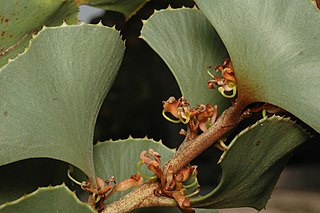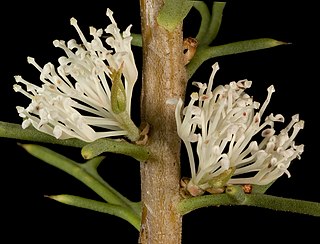
Hakea scoparia is a species of flowering plant in the family Proteaceae and is endemic to the south-west of Western Australia where it grows in shrubland. It is a shrub with ascending branches, terete leaves and clusters of cream to pinkish flowers in leaf axils from June to September.

Hakea nodosa, commonly known as yellow hakea, is a shrub that is endemic to Australia. It usually has golden yellow flowers in profusion and needle-shaped leaves.

Hakea cygna, commonly known as the swan hakea, is a species of flowering plant in the family Proteaceae. It usually grows as a dense shrub with creamy-white upright flowers appearing from July to August. It is endemic to Western Australia.

Hakea amplexicaulis, commonly known as prickly hakea, is a shrub endemic to south west Western Australia. An attractive small shrub with unusual stem clasping, sharply serrated foliage and a profusion of sweetly scented variable coloured flowers from late winter to spring.

Hakea trifurcata, commonly known as two-leaf, two-leaved hakea, or kerosene bush, is a shrub, endemic to the south-west of Western Australia. The species has two leaf forms, needle-like or oblong egg-shaped. Unlike most hakea species the fruit remain green at maturity and resemble the broader leaf form. The mimicry creates a camouflage, reducing predation of the seed by granivores in particular cockatoos.

Hakea rugosa, commonly known as wrinkled hakea or dwarf hakea, is a shrub of the family Proteaceae native to Australia. It has sharp needle-shaped leaves and white or cream fragrant flowers in profusion from August to October.

Hakea undulata, commonly known as wavy-leaved hakea, is a flowering plant in the family Proteaceae and is endemic to the south-west of Western Australia. It has stiff wavy leaves and fragrant cream-white flowers from mid-winter to October.

Hakea cycloptera, commonly known as elm-seed hakea, is a shrub in the family Proteaceae endemic to South Australia. It is a small spreading shrub with an abundance of pale pink or white flowers from December to August.

Hakea cucullata, commonly known as hood-leaved hakea, cup hakea or scallop hakea, is a species of shrub in the family Proteaceae and is endemic to the south-west of Western Australia. It is an attractive shrub with distinctive foliage and beautiful large pink, red, or deep purple scented flowers.

Hakea brownii commonly known fan-leaf hakea is a shrub in the family Proteaceae native to an area in the Wheatbelt region of Western Australia. This species shares a common name with Hakea baxteri due to its distinctive leaves.

Hakea costata, commonly known as the ribbed hakea, is a shrub in the family Proteaceae native to Western Australia. A multi-stemmed small shrub producing attractive pink or white brush-like blooms rich in nectar from July to October.

Hakea erecta is a shrub in the family Proteaceae and is endemic to Western Australia. It is a dense rounded shrub with linear twisted leaves and up to 24 pink or white fragrant flowers appearing in leaf axils in spring.

Hakea ilicifolia is an open shrub or tree in the family Proteaceae and is endemic to Western Australia. It is a small, dense shrub with stiff, lobed leaves and clusters of yellow or creamy-white flowers.

Hakea linearis is a shrub or tree in the family Proteaceae and is endemic to Western Australia. It has smooth branches, mostly linear leaves and white flowers.

Hakea varia, commonly known as the variable-leaved hakea, is a shrub of the family Proteaceae and is endemic to Wheatbelt, South West, Great Southern and Goldfields-Esperance regions of Western Australia. It is a dense prickly shrub with creamy-white or yellow flowers and variably shaped leaves.

Hakea tuberculata is a flowering plant in the family Proteaceae and is endemic to several isolated areas along the coast in the Peel, South West, Great Southern and Goldfields-Esperance regions of Western Australia. It is an upright shrub with white flowers and rigid, prickly leaves.

Hakea obliqua, commonly known as needles and corks, is a shrub in the family Proteaceae and is endemic to an area in the Wheatbelt, Great Southern and Goldfields-Esperance regions of Western Australia.

Hakea stenophylla is a shrub or tree in the family Proteaceae, with sweetly scented creamy-white flowers. It is endemic to Western Australia.

Hakea sulcata, commonly known as furrowed hakea, is a flowering plant in the family Proteaceae and is endemic to Western Australia. It is a prickly shrub with grooved, cylindrical leaves, sweetly-scented flowers and relatively small fruit.
Hakea leucoptera subsp. sericipes is a small tree with cylinder-shaped leaves and clusters of up to forty-five white fragrant flowers. It is found in northwestern New South Wales, Queensland and Western Australia.




















